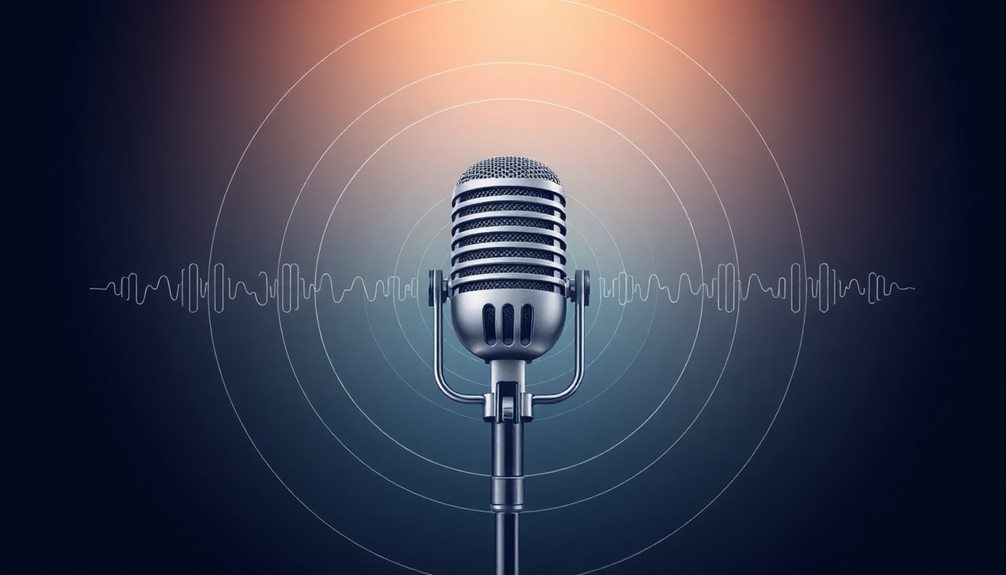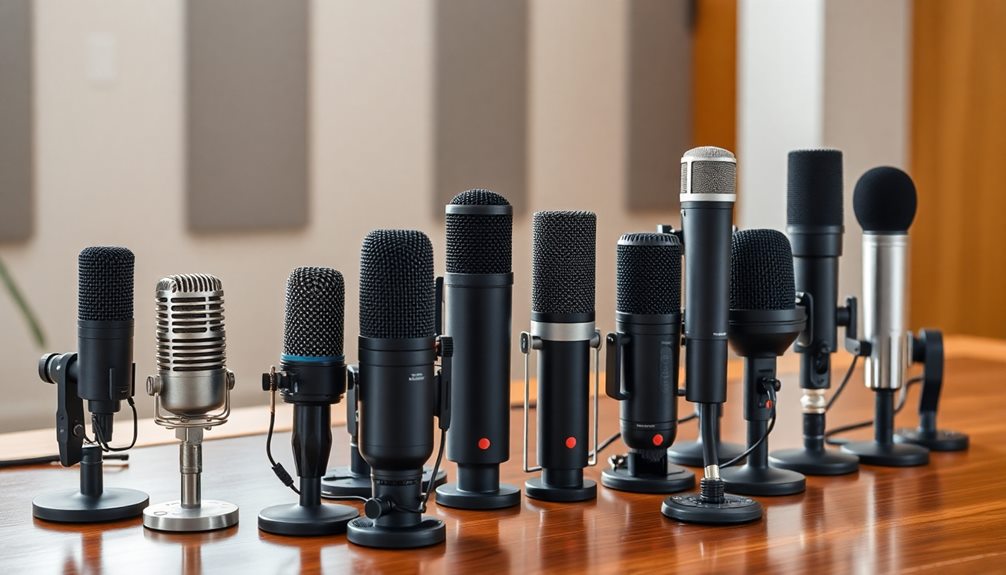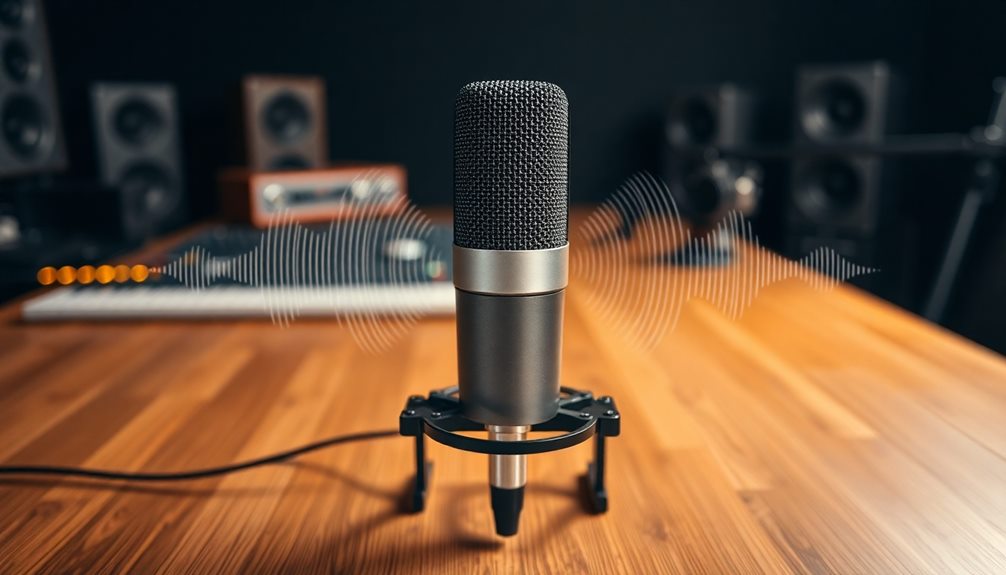A cardioid microphone is super cool because it captures sound mainly from the front while blocking noise from the sides and back. This heart-shaped microphone is perfect for recording your voice clearly, making it a favorite for podcasts, performances, and broadcasts. It's great at minimizing background noise and feedback, which means you can focus on your sound without distractions! You'll love the warm quality it brings, especially when you're close to it. If you're curious about how to use it best or want to check out some great models, there's so much more to discover!
Key Takeaways
- Cardioid microphones feature a heart-shaped polar pattern, capturing sound primarily from the front while minimizing background noise from the sides and rear.
- They are ideal for vocal recording, ensuring clarity and reducing ambient sounds, making them popular in live performances, broadcasts, and podcasts.
- The directional pickup pattern provides excellent noise isolation, allowing for higher gain before feedback in loud environments.
- Cardioid mics enhance bass response through the proximity effect, enriching vocal warmth and presence when positioned close to the sound source.
- Common applications include studio recordings, live sound settings, and podcasting, where clear sound capture is essential.
Definition of Cardioid Microphones
A cardioid microphone is a type of microphone known for its unique heart-shaped polar pattern. This special design makes it super sensitive to sounds coming from the front while blocking out background noise from the sides and rear. Isn't that cool?
Because of this, cardioid microphones are perfect for vocal recording, capturing your voice with incredible clarity. They help reduce those pesky ambient sounds that can ruin your recordings.
With a broad acceptance angle of about 180 degrees, these microphones allow for flexible positioning. You can move them around and still enjoy effective sound isolation. This versatility makes cardioid microphones popular in many places, from live performances to broadcasts and podcasts.
If you want to focus on a specific sound source, like a singer or an instrument, this is your go-to mic!
Whether you're in a studio or a noisy room, a cardioid microphone helps you get the best audio quality. It's like having a superhero for your sound!
Key Characteristics

Cardioid microphones are super cool because they capture sound mainly from the front!
This makes them great for isolating noise and focusing on what you really want to hear.
Whether you're recording a podcast, singing on stage, or chatting with friends, understanding these key characteristics can help you pick the perfect mic for any situation!
Directional Sound Capture
Many audio professionals appreciate cardioid microphones for their unique ability to capture sound directionally. These mics have a special heart-shaped directional pickup pattern that allows them to focus on sound from the front. This makes them ideal for capturing vocals during performances or recordings.
When you sing or speak close to a cardioid mic, it picks up your voice clearly while minimizing background noise, which helps keep the focus on your sound source.
Another great feature is the microphone's ability to reject sound from the sides and rear. This is especially useful in live settings, where unwanted sounds can sneak in and cause problems.
Cardioid microphones excel in close-miking situations, ensuring that your voice shines through even in high sound pressure levels. Plus, they create a delightful proximity effect—when you get closer to the mic, the bass in your voice becomes more pronounced, adding warmth.
Whether you're a singer or an audio engineer, cardioid microphones can elevate your vocal performances. Their focused sound capture makes them a favorite for anyone who wants to create clear, powerful recordings.
Enjoy using these mics, and let your voice be heard!
Noise Isolation Benefits
One of the standout features of cardioid microphones is their exceptional noise isolation, making them a go-to choice for audio professionals. These mics capture sound mainly from the front, which means they're fantastic at rejecting unwanted background noise from the sides and rear. This design helps you focus on the sound you want, like vocal performances, while minimizing distractions from ambient sounds.
With cardioid microphones, you also face fewer feedback risks during live events. Their ability to reject sound from behind allows for higher gain before feedback occurs, so you can turn up the volume without worry.
The gradual drop-off in sensitivity towards the sides means you get improved clarity in recordings, which is perfect for close-miking techniques.
When you're close to the mic, you'll notice the proximity effect, which boosts low frequencies. This creates a warm and rich sound that enhances your vocal recordings.
Ideal Applications Explained
Why are cardioid microphones often the top choice for various audio applications? These microphones shine in many settings thanks to their unique design.
For vocal recording, cardioid microphones capture sound mainly from the front. This means they pick up your voice while reducing background noise and echo, making your recordings clearer and more professional.
In live sound settings, cardioid microphones excel too! They focus on sound sources like your voice or instruments, which helps minimize feedback risks. This makes them perfect for concerts and performances.
You'll also find cardioid microphones popular in podcasting and streaming applications. Here, clarity is key! They cut down on ambient noise, keeping your listeners engaged and enjoying every word.
Even in field recording, cardioid microphones are a great choice. They can capture those unique outdoor sounds while blocking out unwanted background noise.
With their ability to isolate sounds and enhance clarity, cardioid microphones truly shine in these ideal applications. Whether you're singing, speaking, or recording nature, these microphones are your best friends for great audio!
Polar Patterns Explained

Let's explore polar patterns, starting with the cardioid pattern!
This unique shape helps the microphone pick up sound directly in front while blocking out noise from the sides and back.
You'll also discover other polar patterns, each with its own special way of capturing sound!
Cardioid Pattern Characteristics
When it comes to microphone design, the cardioid pattern stands out due to its heart-shaped sensitivity. This unique polar pattern makes it super effective for picking up sound right in front of the microphone, while gradually decreasing sensitivity as sounds come from the sides.
The best part? It features a rear null point, which means it rejects sound from behind. This helps reduce background noise and feedback, especially in live settings.
If you're using a cardioid mic, you'll find it's perfect for vocal performances. It offers clear sound capture, isolating your voice or instrument from unwanted noise around it. This is why it's a favorite for recording in busy environments.
Plus, there's the exciting proximity effect! When you get close to the mic, you'll notice a rich boost in bass response, adding warmth to your audio.
Other Polar Patterns
In the world of microphones, understanding different polar patterns is essential for achieving the best sound capture in various scenarios.
Besides the cardioid pattern, there are several other pickup patterns that can help you in different situations.
The omnidirectional pattern captures sound evenly from all directions, making it perfect for recording ambient sounds or when you have multiple voices in one room. However, it doesn't do a great job minimizing background noise.
On the other hand, the bidirectional pattern, also known as figure-eight, picks up sound from the front and rear while rejecting noise from the sides. This makes it great for duets or interviews!
If you need even more focus, consider supercardioid and hypercardioid patterns. These directional patterns offer tighter front sensitivity than the cardioid pattern.
The supercardioid captures some sound from the back, while the hypercardioid enhances directionality but can pick up a bit of side noise.
Choosing the right polar pattern is all about application suitability. Whether you're isolating sound for vocals or capturing group discussions, knowing these patterns helps you get the best results!
Applications and Uses

Utilizing cardioid microphones in various settings maximizes their effectiveness, making them a popular choice for both professional and personal applications.
These microphones are fantastic for vocal recording because they mainly pick up sound from the front. This means you'll hear your voice clearly while minimizing background noise.
In live performance settings, cardioid mics amplify vocals and instruments beautifully. They help to reduce feedback from monitors, so your audience enjoys a cleaner sound.
When it comes to podcasting, these microphones shine by isolating the speaker's voice, enhancing clarity, and keeping listeners engaged.
In studio recordings, cardioid microphones excel at capturing acoustic instruments and vocals with high fidelity. They keep unwanted sound at bay, allowing for a pure audio experience.
You can also use them in conference and meeting rooms. They focus on the speaker's voice, which improves communication clarity and cuts out distracting background noise.
With their versatility and effectiveness, cardioid microphones are perfect for many situations.
Whether you're recording a song, speaking to an audience, or chatting on a podcast, these mics can help you sound your best!
Advantages Over Other Types

Cardioid microphones offer significant advantages over other types, especially in noisy environments. These mics excel in noise isolation, capturing sound mainly from the front while rejecting sounds from the sides and rear. This makes them perfect for live performances and studio recordings, where background noise can be a big problem.
Another great feature is their feedback reduction. In loud settings, cardioid microphones help prevent that annoying feedback you might hear with omnidirectional mics, which pick up sound from all around.
You'll also find that cardioid microphones provide clear sound capture, making them ideal for vocal performances, instruments, and broadcasting.
When you get close to a cardioid mic, you experience the proximity effect. This means it emphasizes low frequencies, adding warmth and depth to your voice.
Plus, they usually have a high gain-before-feedback ratio, so you can crank up the volume without distortion or unwanted noise interference.
Best Practices for Placement

To get the most out of your cardioid microphone, proper placement is key. Position the mic about 6 to 12 inches from your sound source. This distance helps you achieve ideal clarity while minimizing background noise.
Remember, cardioid microphones are most sensitive at the front, so make sure it's pointed directly at the sound source. This way, you can take advantage of its excellent rejection capabilities and avoid feedback.
When you're using the mic for live performances, keep it closer to the source and adjust the levels to maximize gain before feedback occurs. A slight angle can also enhance sound capture and reduce those pesky plosive sounds that pop up during vocal performances.
If you're working with stereo setups, consider using the XY technique. This involves placing two cardioid mics close together to create a tight stereo image without phase issues.
Recommended Models

When choosing a cardioid microphone, you'll find several impressive models that cater to different needs and budgets.
For beginners in home recording, the Maono A04 is a fantastic choice. This USB condenser mic is easy to set up and captures great sound!
If you're looking for studio-grade quality, try the Maono PM422. It has a built-in headphone jack and is perfect for professional use.
For those who need something tough, the Maono HD300T is a dynamic USB microphone that excels at isolating vocals and instruments. It's built to last and works wonderfully in any setting.
If space is a concern, the Maono AU-PM461 has a compact design that fits right into any recording area, while still delivering excellent sound quality.
Lastly, if you're on a budget but want reliable performance, the Maono AU-PM320 is a great option. It offers impressive quality for home recording without breaking the bank.
With so many great choices available, you're sure to find a cardioid microphone that suits your style and needs! Happy recording!
Common Misconceptions

Many people hold misconceptions about cardioid microphones that can lead to confusion and improper use. Understanding these can help you make better choices!
Here are four common misconceptions to watch out for:
- Equal Sound Capture: Many think cardioid microphones capture sound equally from all directions, but they mainly pick up sound from the front and reduce noise from the sides and rear.
- No Power Needed: Some believe these microphones don't need extra power. In fact, most condenser cardioids require phantom power to work their best!
- Complete Noise Elimination: It's a myth that they can eliminate background noise completely. They can still capture some ambient sound, especially in noisy places.
- Only for Vocals: While great for vocal applications, cardioid microphones are versatile! They can also capture various sound sources, like musical instruments or live performances.
Frequently Asked Questions
What Is a Cardioid Microphone Used For?
You'll find cardioid microphones perfect for vocal recordings, live performances, and podcasts. They capture sound from the front while minimizing background noise, ensuring clarity and focus, making them ideal for various audio applications.
What Are the Disadvantages of Cardioid Microphones?
When it rains, it pours, and cardioid microphones can complicate your recording. They struggle with ambient sound, require precise positioning, and may exaggerate low frequencies, making them less versatile in dynamic environments like live performances.
What Does a Cardioid Do?
A cardioid microphone captures sound from directly in front while minimizing noise from the sides and back. This design helps you achieve clearer recordings, making it perfect for vocals and instruments in noisy environments.
How to Speak Into a Cardioid Microphone?
To speak into a cardioid microphone, position it 6 to 12 inches away, face the front, maintain a consistent distance, and consider using a pop filter to minimize plosive sounds for clearer recordings.
Conclusion
In a world full of sounds, cardioid microphones shine like stars in the night sky! They capture your voice clearly while blocking out distracting noises. Whether you're singing, podcasting, or recording, these mics are your best friends. Remember to place them right, and you'll be amazed at the difference! So, immerse yourself in the world of cardioids and let your voice be heard. With the right mic, you'll create magic, one word at a time!









